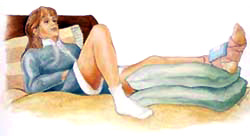"I have frequent cravings for sugar and
carbs when I'm stressed out. I literally sit at my desk and think about pizza
or... my ideal meal is a plate of Doritos covered in cheese.
When I'm stressed, I eat whatever I want because I'd rather not
think about it, but usually it just ends up stressing me out because I don't
want to get fat.
Why does this happen and how can I eat to help curb these
cravings without eating like a fat-ass!??
By:
Sarah Worah, RD
Explore
Fitness Nutrition Coach
This
is a very common question I get from many of my clients. You are not alone!
When the body is stressed it wants a quick fix and our basic instinct tells us
to grab foods high in fat and sugar. The flaw in this is that in time, these
foods will inflict a greater stress response to the body and can also lead to
other health problems down the road such as diabetes, depression, and
cardiovascular problems. These foods also set you up for an initial spike in
energy, but an inevitable crash later.
The
best way to avoid these cravings is to try to set yourself up for success at
the beginning of the day. Do this and you will be less likely to get even more stressed
and cave into the cravings. This means eating a healthy, energizing breakfast
and eating healthy snacks every 3-4 hours to keep your blood sugar steady and
energy levels high.
Examples
of a good breakfast include a mix of lean protein, complex carbohydrates, and
healthy fats. One of my favs is a piece of whole grain toast with smashed
avocado and goat cheese and a fried egg on top. Pair it with a piece of fruit
and you will ready to start the day.
Next,
you will definitely need to keep healthy snacks on hand. This takes the guesswork
out of eating healthy so every time you get hungry, you do not have to think about
what to eat, because it’s right there in your desk drawer or office fridge
waiting for you.

Some
of the best nutrients to combat stress include B vitamins, proteins, healthy
fats (especially omega 3’s), vitamins A and C, and magnesium. Including these
not only in your snacks, but in your overall diet will help better equip your
body to deal with stress and will help you handle the situation better without
giving in to temptations.
Examples
of some great snacks to have on hand throughout the day are nuts, string
cheese, hard-boiled eggs, fresh fruit, nuts, yogurt or veg packs with a Greek
yogurt dipping sauces. My favorite go-to snack is 6oz non-fat Greek yogurt
mixed with 1 tbs. slightly warmed almond or peanut butter, and a handful of
berries.
Having
a plan is the key to avoiding these stress induced, Dorito crazed attacks.
Along with the above suggestions try planning your week out every Sunday so you
have an action plan for healthy eating. Then, when stress creeps up, which it
eventually will, it won’t be so hard to say no to the comfort food you crave
and easier to reach for a healthier, energizing snack or meal.
Another
thing to look at is what is causing the stress? In order to reduce these
cravings, you need to try to reduce the stress. Start to recognize the warning signs of
stress. Do you start to get anxious? Are you irritable? Do your muscles get
tight? Once you recognize when these symptoms are coming on you can start to
react before it gets out of control.
Make
a list of distractions or things to reduce the stress that do not revolve
around food. Can you go for a walk? Watch a funny video on YouTube? Walk to a
co-workers cubicle and check-in on their day?
Other
helpful tips to eliminate stress in your life are do not skip meals. Like I
said earlier, stick to a regular eating schedule and try to fuel your body with
mini meals every 3-4 hours. Keep a record of your eating habits, mood, and
behavior so you can start to recognize patterns. One you identify the cause of
stress, you can start to work on how to overcome them. Engage in regular
physical activity (come to an Explore class at lunch!) and make sure you are
getting adequate sleep- at least 7-8 hours per night.
For
additional tips and resources about eating healthy and dealing with stress,
email me at sarah@explorefitness.com.







